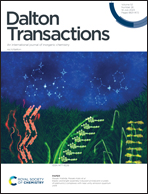Low-melting multicharge ionic liquids with [Ln(NO3)5]2− (Ln = Ho–Lu): structural, electrostatic, thermochemical, and fluorescence properties†
Abstract
A series of green and safe heavy-rare-earth ionic liquids were obtained using a straightforward method. The stable structures of these ionic liquids, characterized by high-coordinating anions, were confirmed by nuclear magnetic resonance (NMR) spectroscopy, infrared (IR) spectroscopy, and single crystal X-ray diffraction (XRD). These ionic liquids exhibited wide liquid phase intervals and excellent thermal stability. The bidentate nitrato ligands occupied a sufficient number of coordination sites on the lanthanide ions, resulting in the formation of water-free 10-coordination structures. To explain the anomalous melting points observed in these multi-charged ionic liquids, a combination of experimental data and theoretical studies was employed to investigate the relationship between the electrostatic properties and the melting point. The electrostatic potential density per unit ion surface and volume were proposed and utilized for melting point prediction, demonstrating good linearity. Furthermore, the coordinating spheres of the lanthanide ions in these ionic liquids were devoid of luminescence quenchers such as O–H and N–H groups. Notably, the ionic liquids containing Ho3+, Er3+, and Tm3+ exhibited long lifetime near-infrared (NIR) and blue emissions, respectively. The UV-vis-NIR spectra revealed numerous electronic transitions of the lanthanide ions, which were attributed to their unique optical properties.
![Graphical abstract: Low-melting multicharge ionic liquids with [Ln(NO3)5]2− (Ln = Ho–Lu): structural, electrostatic, thermochemical, and fluorescence properties](/en/Image/Get?imageInfo.ImageType=GA&imageInfo.ImageIdentifier.ManuscriptID=D3DT00937H&imageInfo.ImageIdentifier.Year=2023)


 Please wait while we load your content...
Please wait while we load your content...